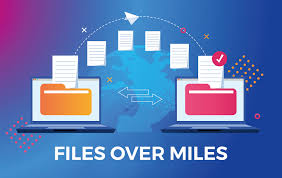Revolutionizing Collaboration: The Rise of files over miles

Introduction
files over miles In our ever-connected digital world, the ability to share files seamlessly across vast distances has become a cornerstone of modern communication and collaboration. The evolution of remote file sharing has not only transformed how we work but has also revolutionized industries, opening up new possibilities for innovation and efficiency. In this comprehensive guide, we delve deep into the world of remote file sharing, exploring its technologies, benefits, challenges, and future trends files over miles.
Understanding files over miles
Remote file sharing, at its core, is the process of exchanging digital files between users who are geographically separated. This can encompass a wide range of technologies and platforms, from cloud storage services like Dropbox and Google Drive to peer-to-peer networks and FTP (File Transfer Protocol) servers. One of the key drivers behind the rise of remote file sharing is the increasing globalization of businesses and the growing trend towards remote work. As teams become more distributed, the need for efficient and secure methods of sharing files becomes paramount files over miles.
Technologies Powering files over miles
Several technologies power remote file sharing, each with its own strengths and weaknesses. Cloud storage services, such as Amazon S3 and Microsoft OneDrive, offer convenient and scalable solutions for storing and sharing files over the internet.
These platforms provide users with access to their files from any device with an internet connection, making collaboration seamless and effortless. Peer-to-peer networks, on the other hand, rely on decentralized architectures, allowing users to share files directly with one another without the need for a central server files over miles.
Benefits of Remote File Sharing
The benefits of remote file sharing are manifold, spanning across various industries and use cases. For businesses, remote file sharing facilitates collaboration among distributed teams, enabling employees to work together on projects regardless of their location.
This has been particularly advantageous in recent years with the rise of remote work arrangements, allowing companies to tap into a global talent pool without the constraints of physical proximity. Additionally, remote file sharing offers increased accessibility to files, allowing users to access their documents, photos, and other media from anywhere, at any time files over miles.
Challenges and Risks
Despite its many benefits, remote file sharing also presents several challenges and risks. One of the most significant concerns is the security of sensitive data being shared over the internet. With cyber threats on the rise, organizations must implement robust security measures to protect their files from unauthorized access and data breaches. Additionally, legal and compliance issues can arise when sharing files containing personal or confidential information, necessitating careful adherence to regulations such as GDPR and HIPAA files over miles.
Best Practices for Secure Remote File Sharing
To mitigate the risks associated with remote file sharing, it is essential to implement best practices for security. This includes encrypting files both in transit and at rest, using strong authentication methods to control access, and regularly auditing and monitoring file activity for any suspicious behavior. Furthermore, educating employees about the importance of security and providing training on safe file sharing practices can help reinforce a culture of security within an organization files over miles.
Remote File Sharing in Various Industries
Remote file sharing has found applications across a wide range of industries, each with its own unique needs and challenges. In healthcare, for example, secure file sharing is essential for protecting patient data privacy and complying with regulations such as HIPAA.
Remote collaboration in the creative industry relies heavily on the ability to share large media files quickly and efficiently, while in education, remote file sharing has become integral to facilitating distance learning and enabling access to educational resources from anywhere in the world files over miles.
Case Studies
Examining real-world case studies provides valuable insights into the practical applications of remote file sharing and the impact it can have on businesses and organizations. One such example is the adoption of cloud-based file sharing solutions by a global marketing agency to streamline collaboration among its dispersed teams. By migrating their file storage to the cloud, the agency was able to improve productivity, reduce costs, and enhance data security, ultimately gaining a competitive edge in their industry files over miles.
Future Trends in Remote File Sharing
Looking ahead, the future of remote file sharing promises to be shaped by emerging technologies and shifting trends in the digital landscape. One significant trend is the increasing adoption of blockchain technology for secure and decentralized file sharing.
By leveraging blockchain’s immutable ledger and cryptographic protocols, developers are exploring new ways to enhance the security and transparency of file sharing networks. Additionally, advancements in artificial intelligence and machine learning are poised to revolutionize how files are stored, organized, and accessed, ushering in a new era of intelligent file sharing solutions files over miles.
Impact of Remote File Sharing on Work Culture
The widespread adoption of remote file sharing has had a profound impact on work culture and the way teams collaborate. With the ability to share files instantly across distances, remote work has become more feasible and prevalent than ever before.
This has led to a shift in mindset towards flexible work arrangements, with many companies embracing remote work as a permanent fixture of their organizational structure. As a result, employees enjoy greater autonomy and work-life balance, while companies benefit from increased productivity and reduced overhead costs associated with traditional office spaces files over miles.
Environmental Impact
In addition to its economic and social implications, remote file sharing also has significant environmental benefits. By reducing the need for physical file transportation and minimizing reliance on paper-based documents, remote file sharing helps to lower carbon emissions and conserve natural resources.
Furthermore, the proliferation of cloud-based storage solutions has led to the consolidation of data centers, which are more energy-efficient and environmentally friendly than traditional server infrastructure files over miles.
Balancing Convenience with Security
Finding the right balance between convenience and security is essential when implementing remote file sharing solutions. While it is tempting to prioritize ease of use and accessibility, organizations must not overlook the importance of maintaining robust security measures to protect sensitive data. This requires a holistic approach that incorporates encryption, access controls, and user education to ensure that files are shared safely and securely without compromising usability.
The Role of Regulation and Compliance
As remote file sharing becomes increasingly prevalent, regulators are taking notice and enacting laws to govern its use and ensure the protection of user privacy and data security. Regulations such as the General Data Protection Regulation (GDPR) in Europe and the Health Insurance Portability and Accountability Act (HIPAA) in the United States impose strict requirements on organizations handling sensitive data, including provisions for data encryption, access controls, and breach notification. Compliance with these regulations is not only a legal obligation but also essential for maintaining trust and credibility with customers and stakeholders files over miles.
Ethical Considerations
In addition to legal and regulatory considerations, there are also ethical implications associated with remote file sharing. Organizations must be mindful of how they handle user data and ensure that they are acting ethically and responsibly at all times.
This includes respecting user privacy, obtaining consent before sharing personal information, and being transparent about how data is collected, stored, and used. By adhering to ethical principles and demonstrating integrity in their actions, organizations can build trust and foster positive relationships with their customers and communities.
Cultural Impacts of Remote File Sharing
The rise of remote file sharing has not only transformed the way we work but also the way we connect and communicate with one another on a global scale. By breaking down geographical barriers and enabling instant communication and collaboration, remote file sharing has facilitated the exchange of ideas, knowledge, and culture across borders and continents. This has led to greater cultural diversity and understanding, as individuals from different backgrounds come together to collaborate on projects and share their unique perspectives and experiences.



